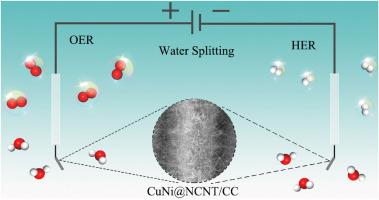氮掺杂碳纳米管中铜调制镍纳米粒子的高效电催化盐水分解
IF 8.3
2区 工程技术
Q1 CHEMISTRY, PHYSICAL
引用次数: 0
摘要
调节催化剂的电子结构以促进析氢反应(HER)和析氧反应(OER)是实现高效、持久水电解的关键。在本研究中,我们合成了包裹在碳布(CuNi@NCNT/CC)上的氮掺杂碳纳米管(NCNT)中的cu掺杂Ni纳米颗粒(NPs)作为高性能双功能电催化剂。实验表征和密度泛函数理论(DFT)计算表明,CuNi@NCNT/CC中的CuNi协同作用优化了电子结构和d带中心,平衡了反应中间体的吸附/解吸自由能,显著降低了HER和OER速率决定步骤的能垒,从而加速了反应动力学。因此,组装的水电解槽在1.0 M KOH下,在10 mA cm−2下达到1.50 V的低电池电压。此外,即使在1m KOH +0.5 M NaCl中,CuNi@NCNT/CC只需要1.52 V就可以输出10ma cm−2。此外,NCNT的封装使催化剂具有优异的稳定性,即使在100和500 mA cm - 2的1 M KOH +0.5 M NaCl条件下,也能保持200小时以上的高效整体水分解性能。这项工作为通过电子结构调制开发具有鲁棒性的双功能电催化剂提供了一种合理的设计策略。本文章由计算机程序翻译,如有差异,请以英文原文为准。

Copper-modulated nickel nanoparticles embedded in nitrogen-doped carbon nanotubes for efficient electrocatalytic saline water splitting
Modulating the electronic structure of catalysts to enhance the hydrogen evolution reaction (HER) and oxygen evolution reaction (OER) is critical for advancing efficient and durable water electrolysis. In this study, we synthesize Cu-doped Ni nanoparticles (NPs) encapsulated in nitrogen-doped carbon nanotubes (NCNT) supported on carbon cloth (CuNi@NCNT/CC) as a high-performance bifunctional electrocatalyst. Experimental characterization and density functional theory (DFT) calculations demonstrate that the CuNi synergy in CuNi@NCNT/CC optimizes the electronic structure and d-band center, balances the adsorption/desorption free energies of reaction intermediates, and significantly lowers the energy barriers for the rate-determining steps of HER and OER, thereby accelerating reaction kinetics. As a result, the assembled water electrolyzer achieves a low cell voltage of 1.50 V at 10 mA cm−2 in 1.0 M KOH. Furthermore, even in 1 M KOH +0.5 M NaCl, the CuNi@NCNT/CC only requires 1.52 V to deliver 10 mA cm−2. Additionally, the NCNT encapsulation endows the catalyst with exceptional stability, maintaining efficient overall water splitting performance for over 200 h even in 1 M KOH +0.5 M NaCl for 100 and 500 mA cm−2. This work provides a rational design strategy for developing robust bifunctional electrocatalysts through electronic structure modulation.
求助全文
通过发布文献求助,成功后即可免费获取论文全文。
去求助
来源期刊

International Journal of Hydrogen Energy
工程技术-环境科学
CiteScore
13.50
自引率
25.00%
发文量
3502
审稿时长
60 days
期刊介绍:
The objective of the International Journal of Hydrogen Energy is to facilitate the exchange of new ideas, technological advancements, and research findings in the field of Hydrogen Energy among scientists and engineers worldwide. This journal showcases original research, both analytical and experimental, covering various aspects of Hydrogen Energy. These include production, storage, transmission, utilization, enabling technologies, environmental impact, economic considerations, and global perspectives on hydrogen and its carriers such as NH3, CH4, alcohols, etc.
The utilization aspect encompasses various methods such as thermochemical (combustion), photochemical, electrochemical (fuel cells), and nuclear conversion of hydrogen, hydrogen isotopes, and hydrogen carriers into thermal, mechanical, and electrical energies. The applications of these energies can be found in transportation (including aerospace), industrial, commercial, and residential sectors.
 求助内容:
求助内容: 应助结果提醒方式:
应助结果提醒方式:


